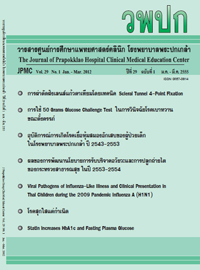ไวรัสที่ทำให้เกิดอาการคล้ายไข้หวัดใหญ่ในเด็กและอาการแสดงในช่วงทีมี Pandemic H1N1
Main Article Content
Abstract
Background: To identify the viral pathogen associates with ILI in children. And secondary aim is to determine age group and season associated with viral pathogen and clinical presentations of ILI due to specific viral pathogens. Method: Virological influenza surveillance was conducted by collecting throat swab specimens for viral culture in children 0-15 years who came to hospital with ILI during pandemic H1N1. ILI criteria is fever > 38๐ C with cough or sore throat. Result : 259 throat samples were collected and 130 (50%) were positive for virus: 28% for Influenza A (H1N1) virus, 24% for respiratory syncytial virus (RSV), 12% for parainfluenza type 1, 8% for influenza A (H3), 7% for adenovirus, 5% for human metapneumovirus, 3% for influenza B, 3% for parainfluenza type 3, 1.5%for parainfluenza type 2. RSV is most common detected in children < 2 years and influenza virus is most common detected in children 2-15 years. Influenza and RSV were most detected during rainy season. In multivariate analysis, positive predictor of influenza infection was sore throat (OR = 2.380, 95% CI = 1.121-5.055 ), whereas runny nose (OR = 5.155, 95% CI = 1.153-23.048 ) was associated with RSV infection. Conclusions: Influenza positive cases were more frequent among children aged 2- 15 years old during pandemic H1N1. However, in children < 2 years, the dominant virus is RSV. ILI may be difficult to distinguish on clinical presentations. We found patient with influenza infection was associated with sore throat more than other virus.
Article Details
Issue
Section
Original article
